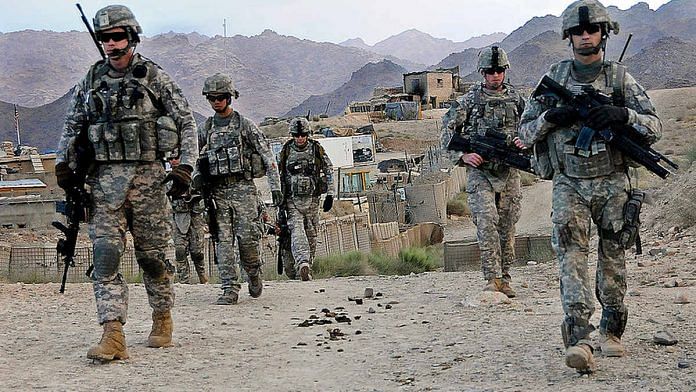
Thank you dear subscribers, we are overwhelmed with your response.
Your Turn is a unique section from ThePrint featuring points of view from its subscribers. If you are a subscriber, have a point of view, please send it to us. If not, do subscribe here: https://theprint.in/subscribe/
“You have the watches; we have the time.” – Taliban to the USA, 2001. How correct these medieval-styled terrorists have proved to be in America’s longest war. The Taliban currently control 85% of Afghan territory or so they claim. Exaggeration aside, the Taliban regime is now a reality.
During their previous rule from 1996-2001, anyone who did not agree with the Taliban’s preposterous laws was either stoned, lynched, whipped or raped to death. The crucifying truth is that the sheer hubris of American politicians is leaving Afghanistan worse off today than what it was yesterday.
Regardless, don’t let anyone fool you into believing that Afghans will be the only one worse off post this meaningless war. Americans, too, will pay their fair share. A close look at the US’ unemployment numbers, income inequality, out-of-pocket health expenditures, and crime rates post 9/11, indicate why it is now known as a ‘Third World country in a Gucci Belt’. China is poised to take over as the world’s biggest economy in GDP terms by 2032 and Americans could not have chosen a better location to hand over the crown: Afghanistan – the Graveyard of Empires.
It is an interesting study why Afghanistan has earned this notorious nickname. Be it the Mughals in their later half or the English in the mid-19th century, the Soviets in 1980s or more recently the Americans – there is a long list of glorious ‘have beens’ who dug their own grave here. Despite winning all the battles, these powers have invariably lost the war. Let us analyse how.
Afghanistan is rich with different tribes who have endured foreign invasions for centuries now. It has always been controlled by local tribe leaders, or warlords as the western media would call them. The Durand Line (Afghanistan-Pakistan border) cuts across territories with similar tribes on either side, primarily Pashtuns. These tribes had shared deep cultural, commercial and familial relations before they got suddenly hampered by the Durand Commission in 1893.
Obviously, these tribes never consented to it and refused to accept the high-handedness of western powers. Resultantly, the Durand Line has remained the bone of contention between Afghanistan and Pakistan to this date. Even today, tribes in different parts of Afghanistan constantly battle for controlling what ‘they’ perceive as their territory, not what some imperial power had dictated. In fact, many of them see the very concept of nation-state as a subduction to western powers and threat to their own cultural identity. This is extrapolated to the mass assumption that the democratically elected government in Afghanistan is nothing but a puppet in the hands of the US.
The Taliban thrive on such strong opinions. Majority of their rank and file come from Pashtuns and they’ve always had a strong presence around the Durand Line and herein lies the playbook of graveyard. Every foreign power which has tried capturing Afghanistan has followed these similar set of steps.
Step 1- Come in all guns blazing and capture large territories, drawing first blood.
Step 2- Get in bed with different “warlords” at different locations because the captured territories cannot be controlled without their support.
Step 3-Keep an eye out for the defectors as any warlord could turn rogue anytime.
Step 4- Repeat.
This is a cumbersome process, akin to fighting a thousand wars within just one. After the initial losses, local resistances go into hiding and the foreign power arrogantly perceives victory. It is precisely at this moment that its vanity comes before fall. The resistances start secretly residing in complex local geographies, initiating the most successful and tactical weapon in the history of warfare- the guerrilla warfare.
Guerrilla warfare is an endless game of waiting while bleeding your opponent to death. It involves the arc of hide-fire-hide with small but continuous strikes. Obviously, only someone with deep knowledge of local geography can successfully play this game. Since the recruits of resistances are mostly locals, they naturally have the advantage at playing this game of infinite waiting: waiting for the foreign aggressor to drain out all resources and grow impatient; waiting for it to frustratingly quit, even from a position of advantage. While the aggressor is anxiously playing to close the game, the local power is calmly playing to just prolong it. Even with all the money and might of NATO, the tech and stealth of UAVs, Americans managed to only do what their predecessors had done – make early gains only to willingly lose it all in the end, thereby re-anointing Afghanistan with the proverbial title: ‘Graveyard of Empires.’
An interesting life lesson here is that if you are willing to play out the long game and just keep living to fight another day, you will always win – eventually, if not immediately. Because in the end, it is not the number of watches but the amount of time that counts!
Also read: Why the US shouldn’t withdraw all its troops from Afghanistan and Iraq
These pieces are being published as they have been received – they have not been edited/fact-checked by ThePrint.

COMMENTS